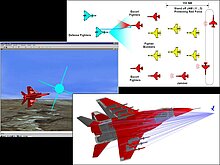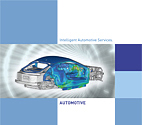- Services
-
Test services and analysis
- Acoustics
- Ballistic investigations, pyro-shock testing
- Determining mass characteristics
- Electromagnetic compatibility
- Testing and fatigue strength
- Services for the construction and agricultural machine industry
- Fatigue strength testing laboratory
- Flight tests
- Functional tests
- High temperature tests
- Climatic Environmental Simulation
- Magnetic field measurement / magnetic field simulation
- Modal test surveys (EMA, OMA)
- Product qualification
- Qualification of Electrical Connectors
- Advanced Composites and Plastic Material
- Qualification & Certification Medical Technology
- Failure Analysis
- Shock Simulations for Naval Platforms
- Structural tests
- Thermal vacuum tests (TV,TB,TD)
- Survivability, vulnerability & effect on target
- Vibration and shock
- Virtual Testing
- Space Simulation
-
Survivability, vulnerability & effect on target
Survivability, vulnerability & effect on target
The lives and health of the soldiers which need to be protected on mission is the highest priority. The interaction of protection and effect plays a vital role here. A relevant factor for the protection and/or survivability is the question whether a possible threat can be avoided or resisted.
For the quantitative evaluation of this survivability we examine the entire opposing effect chain and the capabilities of the own platforms. From discovery to the possible impact of a hit, we merge modelling and simulation data from various disciplines to generate a holistic picture.
Our expertise:
- Susceptibility evaluation of
- signatures (visual, infrared, radar)
- sensor performance
- fire control
- external ballistics
- missile guidance and control
- electronic combat and counter measures
- Vulnerability evaluation
Vulnerability analyses



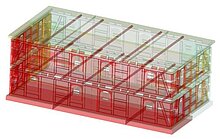
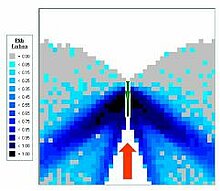
Vulnerability and weapon effect analyses
With the universal vulnerability model UniVeMo we offer a broad spectrum of analytical possibilities regarding vulnerability/ survivability of targets and/or weapon/ ammunition effect. We offer the complete conventional weapon spectrum, from small-calibre infantry weapons, to heavy anti-ship and cruise missiles as well as the applicable target spectrum with representatives. These range from shelters, vehicles, infrastructure, air-borne targets, all the way to ballistic missiles. Our detailed analyses are based on accredited methods in UniVeMo with regard to:
- penetration behaviour
- pressure propagation
- pressure effect
- component damage/ structural failure
- error/ function trees
- repair times
Applications comprise individual weapons and/or ammunition against single targets, all the way to the investigation of effect-based multi-weapon efficiency in complex, e.g. urban scenarios, including collateral damage. The fuse/ seeker behaviour as well as error budget and scattering can be considered. Typical results are:
- single-shot kill probability (SSKP)
- burst effect (MSKP)
- weapon requirements
- lethal areas
- idle times
- hazard areas
Our expertise:
- Weapon effect
- performance data
- penetration behaviour
- pressure propagation, effect
- error budget
- Target vulnerability
- vulnerability model
- founded target information
- error and criticality analyses
- structural and component failure
- national standard
- international comparability
Generation of target vulnerability models
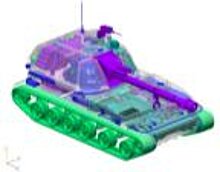

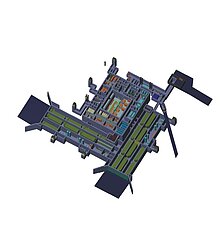
Generation of target vulnerability models
A vulnerability model of the appropriate target is an indispensable precondition for any realistic vulnerability/ weapon effectiveness analysis. A vulnerability model consists of a geometry model, physical description, and functional model as well as distribution functions to guarantee a target description as realistic as possible. The CAD tool-produced geometry model is a detailed three-dimensional illustration of the target including all its dimensions, structures, wall diameters and arrangement of components and groups. The physical description shows used materials and the degree of filling of the components. The functional model comprises the allocation of components to failure criteria such as mobility, fire power and communication as well as their criticality in form of a functional/ error tree. The probability of damage or loss of components by penetrating parts or pressure effects is outlined in form of distribution functions.
Our expertise:
- CAD modelling
- use of state-of-the-art CAD software
- operation standard interfaces
- integration of 3D laser scan data
- visualisation/ animation
- Target vulnerability
- founded target information
- national standard
- international comparability
Release and dispersion of hazardous materials (CBRN)
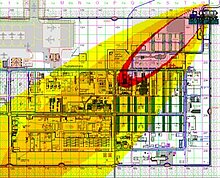
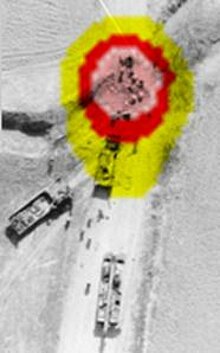



Release and dispersion of hazardous materials (CBRN)
The deliberate and specifically targeted release of military agents (CBRN Defence) is a typical topic which has been supplemented for quite some time by the aspect of indirect weapon effect release, e. g. via toxic chemicals from industrial plants. Characteristic for military or improvised NBC weapon effects and toxic industrial chemicals is the threat developing both temporally and spatially which significantly differs from direct weapon effects. To analyse and evaluate these effects, instruments to measure airborne atmospheric large-scale (major quantities, battlefield) or small-scale (small quantities, urban scenarios) dispersion data are required depending on the scenario. Indoor dispersal is a specific aspect. For complete analysis of threats posed by NBC hazards or the possible collateral damage by weapon effect on industrial plants, it is thus important to consider the following aspects:
- Collection, characterisation and categorisation of risks (threat analysis)
- Scenario creation
- Dispersion calculations
- Analyses of effects
- Evaluation based on individual NBC defence capabilities
- Derivation of measures
We have performed numerous studies for the German Federal Armed Forces (army, navy, armed basis, CBR defence services, Military Science Institute for Defence Technologies - NBC Protection, Munster) on this topic for over 10 years. A current study focuses on the threat of mission contingents, operational real estate and domestic properties by CBRN-IED. IABG has also performed similar studies for civil clients in national and international consortia, e.g. biohazard scenarios for the European Union, CBR risk analyses for an international airport.
Our expertise:
- Risk and threat analyses, military and improvised NBC weapons
- Analysis and evaluation of NBC weapon effects
- Evaluation of technical, organisational and personnel measures of the CBR defence service
- Weapon-related (indirect) release of NBC weapons
- Evaluation of collateral damage
- Dispersion calculations
Universal Vulnerability Model
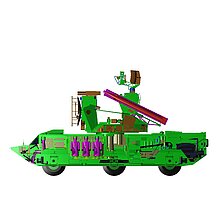

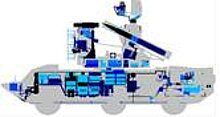
Universal vulnerability model (UniVeMo)
For more than 10 years we have been developing and maintaining the universal vulnerability model (UniVeMo) on behalf the Federal Office of Bundeswehr Equipment, Information Technology and In-Service Support (BAAINBw) as national standard regarding vulnerability and weapon effects. UniVeMo allows to analyse the entire conventional weapon spectrum of the Federal Armed Forces against the applicable target spectrum, while their representatives are listed in an ammunition and target database respectively. Core capabilities of UniVeMo are the investigation of:
- penetration behaviour
- pressure propagation
- pressure effect
- component damage/ structural failure
- error/ function trees
- repair times
which provide the basis to determine the probability of destruction of a target and/or its probability of survival.
Our expertise:
- Weapon effect
- performance data
- penetration behaviour
- pressure propagation, effect
- error budget
- Target vulnerability
- vulnerability model
- founded target information
- error and criticality analyses
- structural and component failure
- national standard
- international comparability
- DIN EN ISO/IEC 27001:2017
- VDA ISA TISAX zertifiziert für die Labels „Informationen mit sehr hohem Schutzbedarf“, „Prototypenschutz“ und „Datenschutz“ für die Standorte Ottobrunn und Lichtenau
- ISO 45001 (Locations Ottobrunn, Lichtenau)
- ISO 14001
- Verzeichnis der Prüfverfahren – Prüflaboratorium DIN EN ISO/IEC 17025 (Standort Lichtenau)
- BSI TR-03140 (TR-SatDS1G) Conformity assessment according to the sateLlite data security act
- ISO 9001
- DIN EN ISO/IEC 17025 for Fatigue Strength Laboratory
- DIN EN ISO/IEC 17025 für das Betriebsfestigkeitslabor - Verzeichnis der Prüfverfahren
- EN 9100
- Accreditation Calibration Lab for Mechanical Units according to DIN EN ISO/IEC 17025
- Accreditation of Testing Lab for Qualification Tests (PLQ) according to DIN EN ISO/IEC 17025
- Certification of Space Test Centre according to ECSS-Q-20-ST-07C
- BSI-certified IT security provider
- AEO (Authorised Economic Operator)
